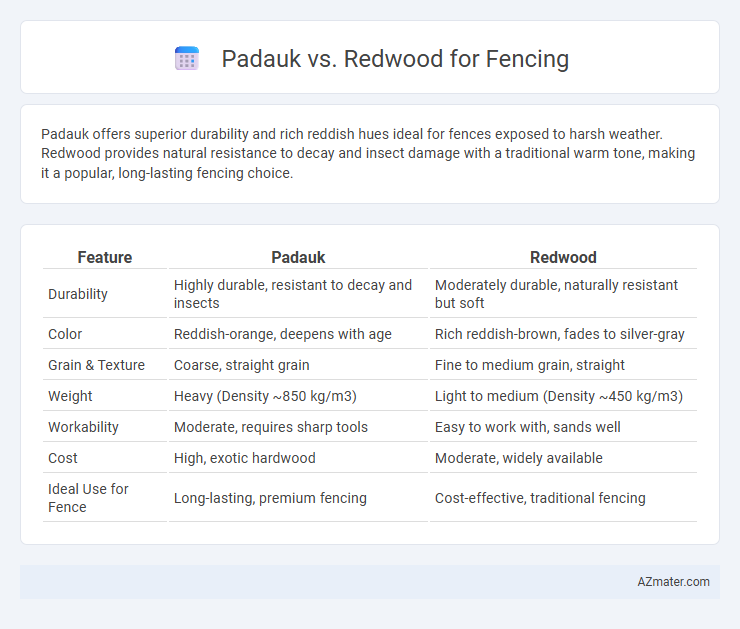Padauk offers superior durability and rich reddish hues ideal for fences exposed to harsh weather. Redwood provides natural resistance to decay and insect damage with a traditional warm tone, making it a popular, long-lasting fencing choice.
Table of Comparison
| Feature | Padauk | Redwood |
|---|---|---|
| Durability | Highly durable, resistant to decay and insects | Moderately durable, naturally resistant but soft |
| Color | Reddish-orange, deepens with age | Rich reddish-brown, fades to silver-gray |
| Grain & Texture | Coarse, straight grain | Fine to medium grain, straight |
| Weight | Heavy (Density ~850 kg/m3) | Light to medium (Density ~450 kg/m3) |
| Workability | Moderate, requires sharp tools | Easy to work with, sands well |
| Cost | High, exotic hardwood | Moderate, widely available |
| Ideal Use for Fence | Long-lasting, premium fencing | Cost-effective, traditional fencing |
Introduction to Padauk and Redwood Fencing
Padauk fencing offers exceptional durability and a rich reddish-orange hue that deepens over time, making it an attractive choice for outdoor use. Redwood fencing is highly valued for its natural resistance to decay and insects, combined with a soft, warm color that blends seamlessly into garden landscapes. Both wood types provide strong, long-lasting fencing options, with Padauk standing out for its vibrant color and hardwood strength, while Redwood is favored for its stability and classic aesthetic.
Wood Characteristics: Padauk vs Redwood
Padauk wood is renowned for its vibrant reddish-orange hue, exceptional durability, and high resistance to rot and insect damage, making it an excellent choice for long-lasting fences exposed to harsh weather conditions. Redwood features a rich reddish-brown color with natural tannins that provide moderate decay resistance and weather stability, though it is generally softer and less dense than Padauk. Both woods offer unique aesthetic appeal, but Padauk's superior hardness and weather resistance make it more suitable for heavy-duty fencing applications.
Durability and Weather Resistance
Padauk wood offers exceptional durability and superior resistance to decay and insect damage, making it a strong choice for fencing exposed to harsh weather conditions. Redwood, known for its natural oils and tannins, provides excellent weather resistance and tends to resist warping and splitting over time. Both woods are durable, but Padauk typically outperforms Redwood in terms of hardness and longevity under extreme weather exposure.
Appearance and Aesthetic Differences
Padauk wood features a striking reddish-orange hue that deepens to a rich, dark brown over time, offering a vibrant and exotic look for fences. Redwood displays warm, earthy tones ranging from light reddish-brown to deep mahogany, with a more uniform grain pattern that provides a classic, natural aesthetic. The bold, dramatic color shifts in Padauk create a modern and eye-catching fence, while Redwood's consistent coloration and smooth texture lend a timeless, rustic appeal.
Maintenance Requirements
Padauk fence boards require minimal maintenance due to their high natural oil content, which resists moisture, insects, and decay without frequent sealing or staining. Redwood fences benefit from their natural tannins that provide moderate resistance to rot and pests but generally need annual sealing or staining to maintain durability and color. Both woods offer durability, but Padauk's maintenance demands are lower, making it ideal for low-upkeep fencing solutions.
Environmental Impact and Sustainability
Padauk wood is prized for its durability and natural resistance to decay, sourced primarily from sustainably managed forests in Africa and Asia, which supports controlled harvesting and conservation efforts. Redwood, native to the western United States, is often harvested from old-growth forests, raising concerns about habitat loss and deforestation; however, certified redwood from sustainably managed plantations offers a more eco-friendly option. Both woods have long lifespans that reduce the need for frequent replacement, but Padauk's faster growth rates generally make it a more sustainable choice for fencing projects with a lower environmental impact.
Cost Comparison: Padauk vs Redwood
Padauk wood typically costs more than redwood due to its exotic origin and vibrant reddish-orange hue, making it a premium choice for fencing. Redwood offers a more budget-friendly option while still providing natural resistance to decay and insects, common in outdoor applications. Evaluating long-term maintenance costs, redwood may require more frequent treatments, potentially increasing its lifetime expense compared to the denser, more durable padauk.
Installation Considerations
Padauk's dense grain and natural oils make it resistant to rot and insect damage, simplifying maintenance during fence installation, while its hardness requires pre-drilling for fasteners to avoid splitting. Redwood offers a softer texture and straight grain, facilitating easier nailing and cutting, but it may need additional treatment to enhance weather resistance over time. Both woods demand proper sealing and regular upkeep to maximize lifespan, with Padauk generally requiring less frequent intervention due to its inherent durability.
Longevity and Performance Evaluation
Padauk offers exceptional longevity with its natural resistance to decay and insect infestation, making it ideal for outdoor fencing in humid or wet environments. Redwood also provides strong durability due to its high tannin content, which acts as a natural preservative, but it may require more maintenance to prevent weathering over time. When evaluating performance, Padauk's dense grain structure ensures superior strength and dimensional stability, while Redwood's lighter weight and workability make it easier to install but potentially less robust under extreme conditions.
Which Wood Is Best for Your Fence?
Padauk offers exceptional durability and vibrant reddish-orange hues that enhance fence aesthetics, making it a top choice for long-lasting, visually striking fences. Redwood is prized for its natural resistance to decay and insect damage, along with warm, rich tones that blend well in outdoor settings. For a fence combining endurance and beauty, padauk suits those seeking bold color and strength, while redwood is ideal for classic, low-maintenance appeal.

Infographic: Padauk vs Redwood for Fence
 azmater.com
azmater.com